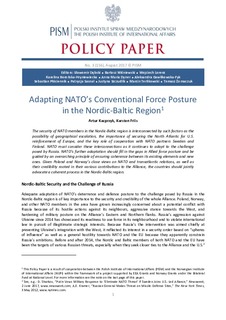| dc.contributor.author | Friis, Karsten | |
| dc.contributor.author | Kacprzyk, Artur | |
| dc.date.accessioned | 2017-09-14T14:46:48Z | |
| dc.date.available | 2017-09-14T14:46:48Z | |
| dc.date.created | 2017-09-01T11:58:11Z | |
| dc.date.issued | 2017 | |
| dc.identifier.uri | http://hdl.handle.net/11250/2454751 | |
| dc.description.abstract | The security of NATO members in the Nordic-Baltic region is interconnected by such factors as the possibility of geographical escalation, the importance of securing the North Atlantic for U.S. reinforcement of Europe, and the key role of cooperation with NATO partners Sweden and Finland. NATO must consider these interconnections as it continues to adapt to the challenge posed by Russia. NATO’s further adaptation should fill in the gaps in Allied force posture and be guided by an overarching principle of ensuring coherence between its existing elements and new ones. Given Poland and Norway’s close views on NATO and transatlantic relations, as well as their credibility rooted in their various contributions to the Alliance, the countries should jointly advocate a coherent process in the Nordic-Baltic region. | |
| dc.language.iso | eng | nb_NO |
| dc.publisher | PISM | nb_NO |
| dc.relation.ispartofseries | PISM Policy Paper;No. 3 (156) | |
| dc.relation.uri | http://www.pism.pl/files/?id_plik=23496 | |
| dc.subject | NATO | |
| dc.subject | Europa | |
| dc.subject | Europe | |
| dc.subject | Forsvar | |
| dc.subject | Defence | |
| dc.title | Adapting NATO’s Conventional Force Posture in the Nordic-Baltic Region | nb_NO |
| dc.type | Research report | nb_NO |
| dc.description.version | publishedVersion | |
| dc.source.pagenumber | 10 | nb_NO |
| dc.identifier.cristin | 1490370 | |
| cristin.unitcode | 7471,12,0,0 | |
| cristin.unitname | Sikkerhet og forsvar | |
| cristin.ispublished | true | |
| cristin.fulltext | original | |
